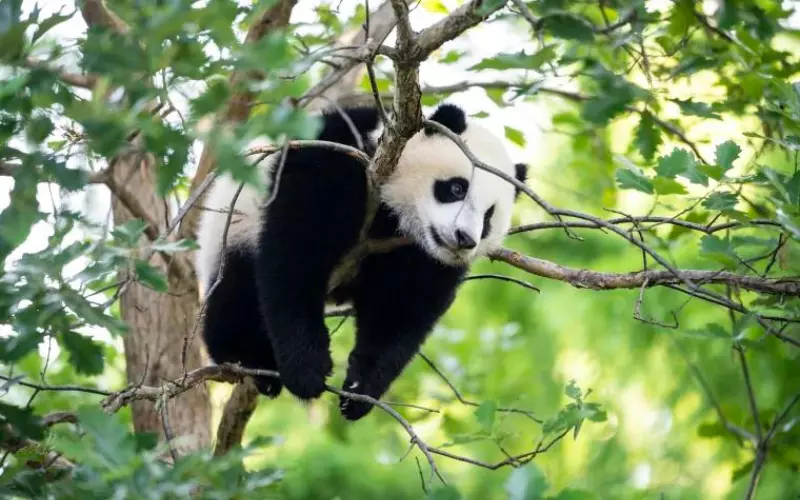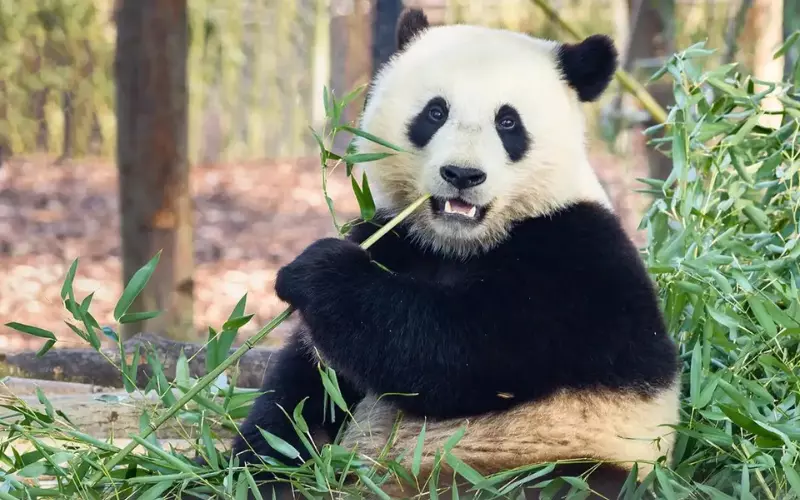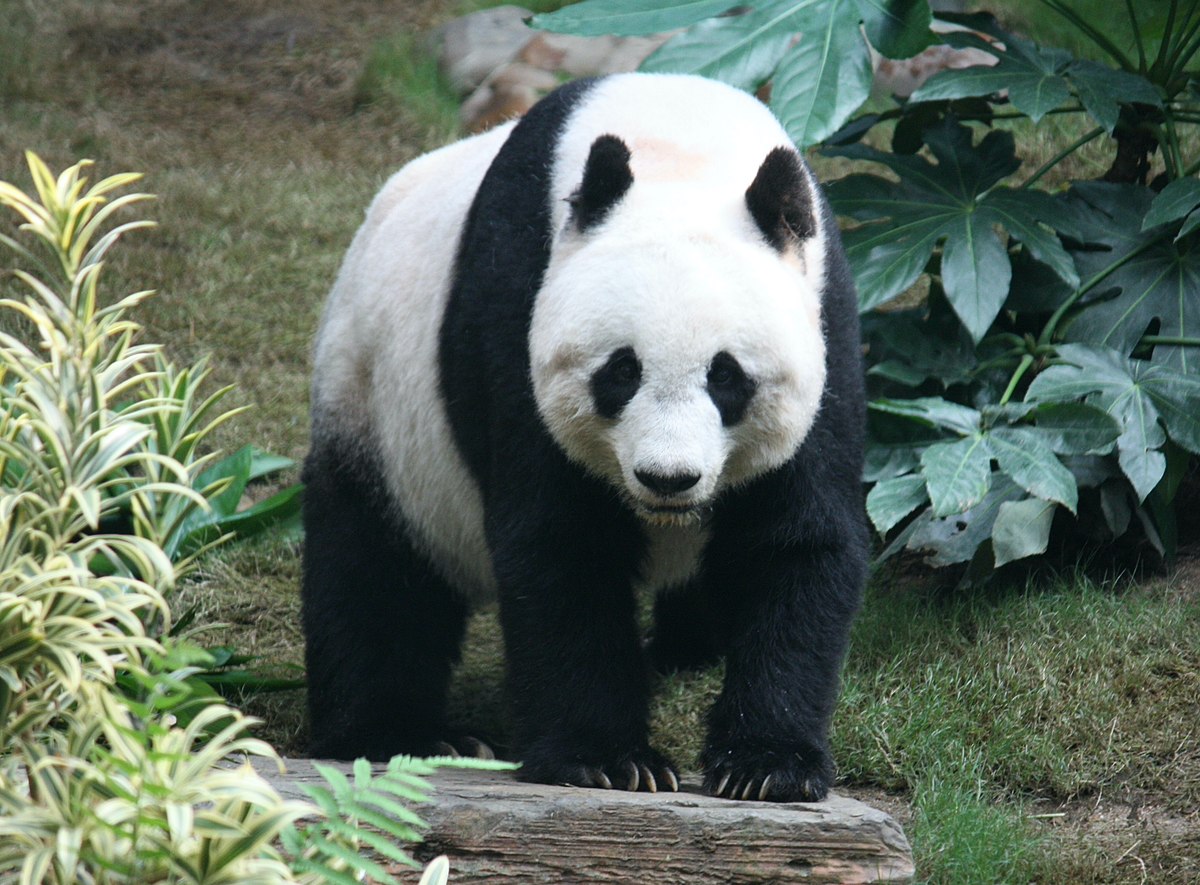Pandas are fascinating animals that capture our attention with their unique appearance and intriguing behaviors. In this blog post, we will explore the history, facts, size, habitat, and classification of the beloved animal known as the panda.
The panda, scientifically known as Ailuropoda melanoleuca, has a rich history that dates back thousands of years. Native to the mountains of central China, pandas have been a symbol of peace and harmony in Chinese culture. Unfortunately, they also faced the threat of extinction due to habitat loss and poaching. However, conservation efforts have been successful in protecting these iconic creatures.
Pandas are easily recognizable with their distinctive black and white fur patterns. They have a stocky build and are about the same size as a medium-sized dog. Despite their weight, pandas are excellent climbers thanks to their strong limbs and sharp claws. They primarily feed on bamboo, which constitutes nearly 99% of their diet, and can eat up to 40 pounds of bamboo each day.
Overall, pandas are classified as bears and belong to the family Ursidae. However, their unique characteristics have caused some scientists to consider placing them in a separate family called Ailuropodidae. Regardless of their classification, pandas continue to captivate us with their charm and serve as a reminder of the importance of protecting our precious wildlife.
History of Panda

The history of pandas is an intriguing tale that stretches back thousands of years. Native to the mountainous regions of China, these adorable creatures have captured the hearts of people worldwide. Pandas, scientifically known as Ailuropoda melanoleuca, are one of the rarest and most endangered species on our planet.
Thought to have existed for over two million years, pandas evolved from a type of ancient bear. These black and white bears have distinctive features such as their round faces, black eye patches, and bamboo-like diet. Legend has it that panda got their unique black and white coat as a reward for saving a young girl from a leopard. This beautiful tale reflects the cultural significance pandas hold in Chinese folklore.
The conservation of pandas became a matter of utmost importance during the 20th century. Their population reached a critical point due to deforestation, habitat loss, and poaching. Recognizing this, the Chinese government established protected areas and implemented breeding programs to safeguard these incredible creatures. Thanks to these efforts, the population of pandas has slowly increased, granting hope for their survival and ensuring the continuation of one of the most cherished species on Earth. Despite the ongoing challenges, today we can find pandas living in various zoos and sanctuaries around the world, symbolizing the importance of preservation and the power of collective action.
Importance of Panda
Pandas are important animals in our world. They are a special kind of bear that lives in China. Pandas are loved by people all around the world because of their unique appearance and gentle nature.
One reason why pandas are important is because they help to keep forests healthy. Pandas mainly eat bamboo, and they eat a lot of it! When pandas eat bamboo, they help to control its growth and prevent it from taking over the forests. This is important because bamboo can grow very fast and can overcrowd other plants. By eating bamboo, pandas make sure that other plants and animals have enough space to live.
Another reason why pandas are important is that they bring in a lot of tourists to China. Many people travel from far away just to see pandas up close in their natural habitat. This tourism brings money to the local communities, which is good for the economy. It also helps to raise awareness and protect the pandas. People who see pandas in person are more likely to care about their conservation and support efforts to save them.
Pandas are important because they help to keep forests healthy and bring tourism to China. We should continue to protect and preserve these wonderful creatures so that future generations can also appreciate their beauty and importance.
Amazing Facts About Panda

1. Pandas are large black and white bears native to China.
2. They have a distinctive appearance with their round bodies, black eye patches, and white faces and bellies.
3. Pandas primarily eat bamboo, which makes up around 99% of their diet.
4. Bamboo is not very nutritious, so pandas have to eat a lot of it to get enough energy.
5. Despite being classified as carnivores, pandas have the digestive system of a herbivore due to their bamboo-heavy diet.
6. Pandas are solitary animals, meaning they prefer to live alone rather than in groups.
7. They have a relatively slow reproductive rate, with females only being able to reproduce for about 2-3 days per year.
8. Baby pandas are born blind and only weigh around 90-130 grams, which is about the size of a stick of butter.
9. Pandas have a thumb-like adaptation on their front paws called a “pseudo-thumb” that helps them grasp bamboo while eating.
10. They are excellent climbers and can also swim.
11. Pandas communicate through vocalizations such as bleats, honks, and growls.
12. Due to habitat loss and low birth rates, pandas were once considered an endangered species.
13. Conservation efforts in China, such as creating protected reserves, have helped increase the panda population in recent years.
14. Pandas have become a symbol of conservation and are highly regarded around the world.
15. They are beloved by many people and are often featured in zoos, where visitors can learn more about these fascinating creatures.
Can we keep Panda as our Pet?
Keeping a panda as a pet is not a good idea for many reasons. First of all, pandas are wild animals and they need a certain kind of environment and diet to stay healthy. They are mainly found in the bamboo forests of China and require a large space to roam freely. It would be very difficult to recreate their natural habitat in a home or a backyard.
Moreover, pandas have special dietary needs that cannot be met in a typical household. They primarily eat bamboo, which makes up about 99% of their diet. Bamboo is not readily available in most places, and it would be quite expensive and challenging to constantly provide enough bamboo for a pet panda. This could lead to malnutrition and health problems for the panda.
Additionally, pandas are an endangered species. There are only around 1,800 pandas left in the wild, and they are protected by strict conservation laws. Keeping a panda as a pet would not only be illegal, but it would also contribute to the decline of this beautiful species. It is important to protect them and their natural habitat to ensure their survival in the long run.
It is not feasible or ethical to keep a panda as a pet. They require a specialized environment, and a specific diet, and are endangered animals that need our protection. It is best to admire these magnificent creatures from afar and support conservation efforts instead.
Size of Panda
Pandas are a unique kind of bear famous for their adorable looks. They are not as big as other bears, but they are still quite large. An adult panda can reach a length of about 5 to 6 feet and stand at a height of 2 to 3 feet at the shoulder. Pandas are also quite heavy, with males weighing around 200 to 300 pounds, while females are slightly smaller, weighing between 150 to 220 pounds.
Despite their size, pandas have a round and chubby appearance, which makes them even more charming. Their bodies are covered in thick, woolly fur that helps them stay warm in their natural habitat, the cold mountainous regions of China. Besides their unique physical characteristics, pandas are best known for their black and white markings, with black patches around their ears, eyes, shoulders, and legs contrasting with their white body.
Compared to humans, pandas are quite big, but when compared to other bears, they are on the smaller side. They have adaptability due to their size and behavior, which includes a diet mainly composed of bamboo. Although they are not large in size, pandas still manage to capture our hearts with their lovable appearance and gentle nature.
Habitat of Panda
Pandas live in a specific habitat in the mountains of China. Their homes are found in the cool and wet bamboo forests. These forests are full of tall bamboo plants, which provide the pandas with their main source of food. The mountains where pandas live have thick vegetation and are covered with mist, creating a tranquil and serene environment.
In the bamboo forests, pandas build their dens in the hollow parts of trees or caves. These dens are important for the pandas to rest and protect their young ones. The thick vegetation provides an excellent hiding place for the pandas, allowing them to blend in with their surroundings and avoid predators. The mist in the mountains also helps to keep the pandas cool during the hot summers and insulates them from the cold winters.
Pandas have evolved to survive in their habitat. Their strong jaw muscles and enlarged molars are specially adapted for chewing bamboo. The bamboo forests provide them with a constant supply of food, as bamboo is available year-round. Pandas spend most of their days eating bamboo because it is low in nutrients, so they need to consume large amounts to meet their energy needs.
Pandas live in the cool and wet bamboo forests found in the mountains of China. They build their dens in the hollow parts of trees or caves, which provide them with shelter and safety. The bamboo forests are their main source of food, and their bodies have adapted to survive on a diet of bamboo.
Classification of Panda

Pandas are fascinating animals that belong to a unique classification known as the bear family. They are classified under the scientific name Ailuropoda melanoleuca, which means “black and white cat-footed.” This gives us a clue about their distinct black and white fur colors and their unique paws that resemble those of a cat.
Pandas are further classified as mammals, which means they are warm-blooded, have hair or fur on their bodies, and give birth to live young ones. They are also categorized as carnivores, although their diet mainly consists of bamboo. This makes them one of the few herbivorous species among the bear family. Their sharp teeth and strong jaws, adapted for eating bamboo, reflect their carnivorous classification.
In terms of size, pandas are classified as large animals, with adult males weighing up to 250 pounds, while females weigh around 220 pounds. They have a stocky body structure with strong legs, which helps them climb trees and move on uneven terrain easily. Despite their large size, pandas are known for their calm and gentle nature, making them beloved creatures.
Pandas belong to the bear family, classified under the scientific name Ailuropoda melanoleuca. They are mammalian carnivores, although they primarily feed on bamboo. With their unique black and white fur and gentle demeanor, these large animals captivate the hearts of people around the world.
Different Types of Panda
1. Giant Panda: The most famous and beloved type of panda, known for its distinctive black and white fur. They are native to the mountainous regions of China and primarily feed on bamboo. Unfortunately, they are endangered due to habitat loss and low birth rates.
2. Red Panda: Often called the “lesser panda,” this small and adorable creature is native to the Himalayas. While resembling a raccoon, it has reddish-brown fur and a long, bushy tail. Red pandas are mostly tree-dwelling and feed on bamboo leaves, fruits, and insects.
3. Qinling Panda: Found only in the Qinling Mountains of China, this type of panda has a smaller population compared to the giant panda and is considered a subspecies. It has a distinct coloring with lighter fur and darker eye patches. It faces similar threats as the giant panda.
4. Ailuropoda microta: Also known as the mini panda, this subspecies is the smallest type of panda. It is native to the subtropical forests of Vietnam and grows to a size similar to a domestic cat. Due to habitat destruction, not much is known about this elusive and rare panda.
5. White Panda: This unusual variant of the giant panda is extremely rare and has a condition called albinism, causing its fur to be completely white. White pandas have been observed in some regions of China, but they face additional challenges due to their lack of camouflage and vulnerability to sunburn.
6. Brown Panda: Another color variation, the brown panda has a coat that ranges from light brown to dark chocolate. While still mainly found in China, these pandas have been reported with higher frequency in the Qionglai Mountains region. They face the same challenges as the giant panda but are less studied.
7. Blue Panda: Despite its name, the blue panda is not actually blue in color. It is a term used to describe a chromosomal abnormality that affects the fur coloration of pandas, creating a bluish-gray tint. The blue panda is extremely rare and has only been reported in a few individuals.
8. Albino Panda: Similar to the white panda, albino pandas have a lack of pigmentation and appear completely pale, with pink eyes. This genetic mutation is even rarer than albinism and affects the production of melanin. Due to their visibility, albino pandas are highly vulnerable to predation in the wild.
9. Brown-and-white Panda: This type of panda has an unusual combination of brown and white fur instead of the traditional black and white pattern. Brown patches can appear in various areas, and these pandas are often considered unique due to their different appearance.
10. Panda Ant: While not a true panda, the panda ant is a species of wingless wasp found in South America. It is known for its distinctive black-and-white pattern, resembling that of a giant panda. The females have stingers and can deliver painful stings, earning them the nickname “cow killer ant.”
Geographical Presence of Panda
Pandas are found in the region of China. They are native to the mountainous areas of southwestern China, particularly in Sichuan, Shaanxi, and Gansu provinces. These regions provide the pandas with the bamboo forests that they rely on for food and shelter. The cool, wet climate of these areas also suits the pandas’ needs.
Pandas are not found in other parts of the world. They are exclusive to China and are considered a national treasure. Despite their popularity and recognition around the globe, pandas cannot be found in countries like Canada, Australia, or Africa. They have a specific habitat requirement and cannot survive outside their natural range.
Conservation efforts have been made to protect pandas and their habitat. In China, various reserves and national parks have been established to ensure the survival of these adorable creatures. These protected areas aim to preserve and restore their natural bamboo forests, as well as provide suitable living conditions for pandas. Additionally, breeding programs have been implemented to help increase the panda population and prevent their extinction.
Diet of Panda’s

Pandas have a unique and specialized diet that is mostly made up of bamboo. They rely on bamboo as their primary source of food. In fact, bamboo makes up about 99% of their diet. These cute and cuddly creatures consume a large amount of bamboo every day to meet their nutritional needs.
Bamboo is a type of grass, but it is not very nutritious compared to other plants. This means pandas have to eat a lot of it to get the nutrients they need. They spend most of their day munching on bamboo stalks, leaves, and shoots, which they can digest thanks to their strong and sharp teeth.
Despite their dependence on bamboo, pandas are also known to eat other foods occasionally. These include fruits, such as apples and oranges, as well as some small animals like rodents or birds. However, these items only make up a small portion of their diet compared to bamboo.
To handle their unique diet, pandas have a specially adapted digestive system. Their bodies can efficiently break down bamboo fibers, thanks to bacteria in their intestines. This helps them extract as many nutrients as possible from the bamboo they consume.
Pandas mostly eat bamboo, which constitutes around 99% of their diet. They have to eat a large amount of bamboo every day since it is not very nutritious. Although they occasionally eat fruits and small animals, it is bamboo that keeps them healthy and sustained. Pandas’ remarkable ability to digest bamboo fibers makes them well-adapted to survive on this specialized diet.
Locomotion of Panda’s
The panda moves around by walking on all four legs. It has a strong body and sturdy limbs that help it to walk comfortably on the ground. Pandas have a unique way of walking – they waddle from side to side, which gives them a cute and clumsy appearance. This waddling motion is due to their wide hips and shorter hind legs. It helps them maintain balance and keeps their center of gravity stable as they move around.
While pandas are primarily terrestrial animals, they are skilled tree climbers too. They have sharp claws that enable them to grip onto trees as they climb. Pandas use both their front and back legs to navigate through the trees, making them quite agile climbers. Their strong limbs and muscular bodies make it easier for them to move from branch to branch, looking for food or escaping from danger.
The panda moves by walking on all four legs and waddles from side to side. They are skilled climbers and use their strong limbs and sharp claws to navigate through trees. Their unique way of moving and adorable appearance makes them a favorite among animal lovers worldwide.
Social and Sexual Behaviour of Panda’s
Pandas, with their distinctive black and white fur, are gentle creatures known for their solitary nature. They prefer to spend most of their time alone, but sometimes they do form small groups called colonies. These colonies can consist of pandas who share the same territory, and they interact with each other occasionally. However, pandas aren’t very social compared to other animals, so their interactions are usually limited.
When it comes to sexual behavior, pandas are quite unique. They have a short mating season, usually occurring in the spring. During this time, female pandas release a scent to attract males. Once a male panda has found a receptive female, mating can take place. However, pandas are not very efficient at reproducing. Female pandas are only fertile for 24 to 72 hours each year, making it difficult for them to find a partner and successfully reproduce.
Pandas are solitary creatures who prefer to spend most of their time alone. While they may form small groups on occasion, they are not very social compared to other animals. When it comes to their sexual behavior, pandas have a short mating season and face challenges in reproducing due to the limited fertility period of the females. Pandas are fascinating creatures with unique behaviors that make them stand out in the animal kingdom.
Reproduction and Lifecycle of Panda’s
Pandas have a unique reproduction and life cycle. The journey begins when a female panda reaches the age of about four to six years old. During the springtime, female pandas become ready to have babies, called cubs. They usually give birth to one or two cubs, but it is very rare to have more than two.
After a pregnancy of around 5 months, the female panda gives birth. The babies are tiny, blind, and unable to move on their own. They are completely dependent on their mother for warmth, protection, and food. The mother panda cares for her cubs very carefully, keeping them close and nourishing them with her milk. As the cubs grow, they start exploring their surroundings but still rely on their mother for guidance.
Within one to two years, the young pandas become more independent. They start learning how to climb and search for bamboo, the main source of their diet. The mother gradually becomes less protective, allowing the cubs to explore further. At around three years old, the cubs become fully independent and begin searching for their own territories in the vast bamboo forests.
The life cycle of pandas continues as the adult pandas find a mate during the breeding season. The cycle then starts all over again. The reproduction and life cycle of pandas play an essential role in preserving the species, as they are currently listed as endangered. By understanding and protecting their unique life cycle, we can contribute to conservation efforts and ensure the survival of these beautiful creatures.
Threats to Panda’s
The adorable pandas that we all love are facing several threats in their natural habitat. One major threat to pandas is habitat loss. As human populations grow, more land is needed for agriculture, infrastructure, and settlements. This means that the forests where pandas live are being cut down, leaving them with less space to roam and find food. Without sufficient habitat, pandas struggle to survive and reproduce.
Another significant threat to pandas is poaching. Sadly, some people hunt these gentle creatures for their fur and body parts, which are highly prized in the illegal wildlife trade. The demand for panda products puts them at risk, as poachers will go to great lengths to fulfill this cruel demand. To protect pandas, it’s crucial to crack down on poaching and enforce strict laws against the illegal trade of panda parts.
Finally, climate change poses a threat to pandas and their bamboo food source. Rising global temperatures and changes in rainfall patterns can alter the growth and distribution of bamboo forests. This directly affects pandas as their diet mainly consists of bamboo. If pandas cannot find enough bamboo to eat, their survival is at risk. It is essential for us to take action against climate change and protect panda habitats to secure their future.
Pandas face many threats such as habitat loss, poaching, and climate change. To ensure the survival of these lovable creatures, we must work together to conserve their natural habitats, enforce laws against poaching, and take measures to combat climate change. Through our efforts, we can protect pandas and help them thrive for generations to come.
Conclusion
Overall, pandas are fascinating animals that have captured the hearts of people around the world. With their unique appearance and gentle nature, they are truly one of nature’s wonders. They have a long history dating back millions of years and have evolved to adapt to their specific habitat. Despite their large size, pandas mainly eat bamboo and live in the dense forests of China.
Pandas belong to the bear family and are known for their distinctive black and white fur. They are classified as vulnerable animals due to habitat loss and low birth rates. Efforts are being made to protect and preserve their habitats, as well as promote breeding programs to increase their population. With increased awareness and conservation initiatives, we can ensure the survival of these magnificent creatures for future generations to enjoy.
The giant panda is a remarkable animal that has captivated people’s attention for centuries. Its history, size, habitat, and classification all contribute to its unique identity as one of the world’s most beloved animals. By learning about pandas and taking action to protect them, we can play a part in preserving the rich diversity of our planet’s wildlife. Let us work together to ensure that the beauty and wonder of these animals continue to inspire and amaze us in the years to come.
FAQ’s
What is a panda?
A panda is a large black-and-white bear-like mammal native to China.
What is the scientific name of the panda?
The scientific name of the panda is Ailuropoda melanoleuca.
Where do pandas live?
Pandas are found in the mountainous regions of central China, mainly in Sichuan, Shaanxi, and Gansu provinces.
Are pandas endangered?
Yes, pandas are currently listed as endangered on the International Union for Conservation of Nature (IUCN) Red List.
What is the diet of a panda?
Pandas are primarily herbivores, with bamboo making up 99% of their diet. However, they may also eat other plants, fruits, and occasionally small mammals.
How much do pandas weigh?
Adult pandas typically weigh between 70 and 125 kilograms (154 to 276 pounds).
What kind of habitat do pandas prefer?
Pandas prefer living in cool and wet bamboo forests with elevations ranging from 1,200 to 3,400 meters (3,900 to 11,200 feet) above sea level.
How long do pandas live?
Pandas have an average lifespan of 14 to 20 years in the wild, whereas pandas in captivity can live up to 30 years.
How many cubs do pandas usually have?
Pandas usually give birth to one or two cubs at a time, although twins are more common.
Why are pandas black and white?
The black and white coloration of pandas helps them blend in with their surroundings, providing camouflage in the dense bamboo forests where they live.
Can pandas swim?
Yes, pandas are capable swimmers and often use water to play, cool off, or reach different areas of their habitat.
Are pandas aggressive?
Pandas are typically docile animals, but they can become aggressive if threatened or provoked.
How fast can a panda run?
Pandas are not known for their speed. They can run at a maximum speed of around 20 miles per hour (32 kilometers per hour) over short distances.
Do pandas have any natural predators?
Adult pandas have no significant natural predators, but young cubs may be vulnerable to predation by snow leopards, yellow-throated martens, and other larger carnivores.
Can pandas be kept as pets?
No, pandas are protected wildlife under Chinese law, and it is illegal to own them as pets. Additionally, pandas have specific dietary and habitat requirements that are difficult to replicate in a domestic setting.

Hi there! I’m Morgan Gutierrez, and I love animals! I work as a Seasonal Animal Care Specialist at Brookfield Zoo and also teach people about animals, which is super fun. I studied at Valparaiso University in Lockport, Illinois, where I learned even more about these amazing creatures.
I’m not just about taking care of animals; I write articles about them, too! I explore and share many interesting animal stories, from cute kittens to giant elephants.
In the past, I’ve worked with veterinarians, helped with research, and even been an Animal Ambassador, bringing animals closer to people. Animals are my passion, and I enjoy helping others learn about them. So, if you ever want to know about animals, feel free to ask. I’ll explain it in a way that’s easy to understand, just like talking to a friend!












